Any prepper worth their salt will have as one of their most prized possessions their survival knife, whatever form that takes.
For my trustworthy folding pocket knife to a beefy bushcraft knife or anything in between, the knife is one of mankind’s most ancient and elemental tools, and one that is directly responsible for helping us to master nature.
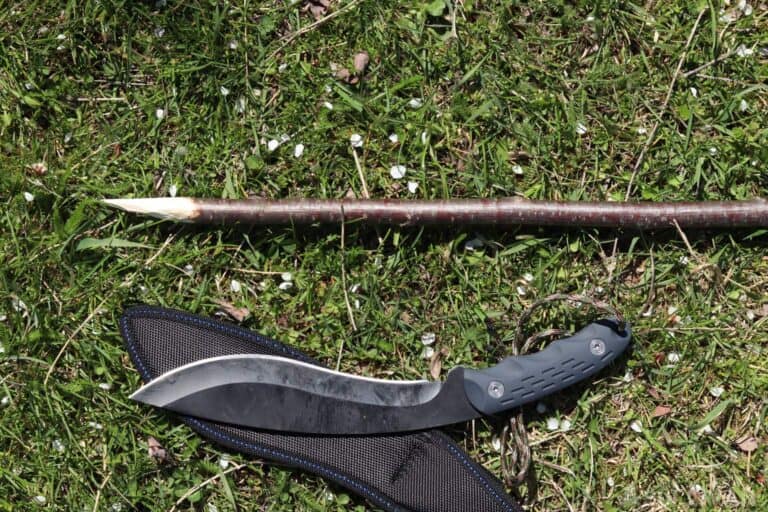
Come on, don’t try to deny it, you love your survival knife. If you don’t need to keep it inside your BOB for emergencies, you’d probably sleep with it under your pillow!
Knives have so many uses it’s not even funny. To prove it to you, I’ve listed as many as I could think of or find here.
To Open a Can
You can indeed use a knife to open most cans. It is not necessarily the best use of it (since it is highly destructive to the knife’s edge), but it can be done in a pinch if all other methods fail or are unavailable.
Also, you should be aware that some fixed blade knives have pointy or chisel shaped protrusions on their pommels that could be useful for this task.
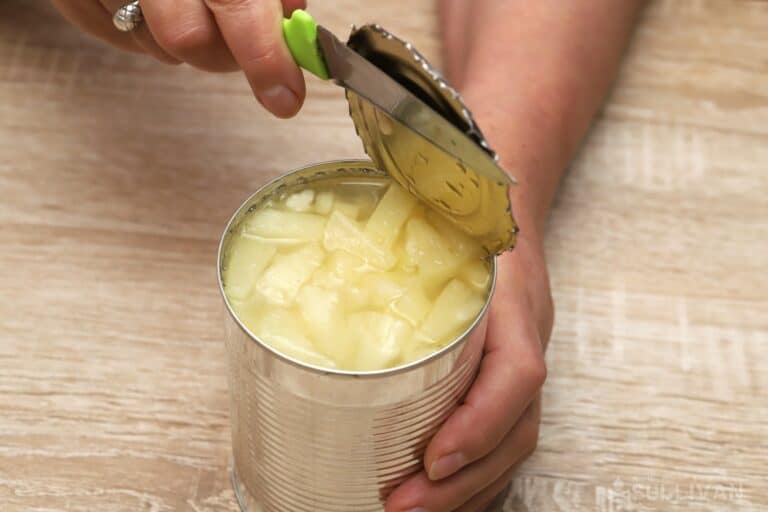
Before you do this, you must place the can on a solid surface such as a table or flat, stable rock. Never put the can on your lap, you’re very likely to get injured.
Position the knife perpendicularly on the edge of the lid, holding it firmly with one hand. Tap the pommel with the other hand until the tip has pierced through the metal can.
Once you made a hole about half an inch wide, you’ve got two choices: you can either continue to pierce holes one next to the other in the same manner or you can hold the can firmly with one hand and begin to enlarge the existing hole by cutting it like you would cut bread.
Simply hold the can at an angle towards you with the left hand and use your right to cut the lid down. Rotate the can inch by inch for almost 180 degrees and keep cutting.
Warning! Do not rotate and cut at the same time! You rotate a little bit, enlarge the hole, then rotate again before continuing the cut.
To Start a Fire
Any quality steel knife that has a substantial spine can be used in conjunction with a ferro rod to help you create a blazing fire in no time.
My scraping or dragging one against the other, you can produce a blazing hot shower of particles from the ferro rod to easily ignite your tinder.
The exact technique will vary slightly depending upon your knife and your ferro rod, as well as user preference, but the following variation seems to work well with an assortment of tools.
Hold the knife in one hand and the rod in the other. You want to place the corner of the knife’s spine (the part of the blade opposite the edge) against the ferro rod.
Begin to pull the rod backwards briskly until you see sparks emitted. If sparks don’t come out the first time, slightly alter the technique until you nail the sweet spot; try changing a single variable at a time until you get it, among them angle of contact, pressure and speed at which you pull the rod.
Some preppers get best results with a quick, light flicking motion. Others use a more forceful but slower scrape.
Don’t despair if it does not work the first few times; once you get it, you’ll have it, just like riding a bike!
Also, keep in mind that the hardness or softness of the ferro rod will affect the technique, so you might have to change it up if you switch brands of rod!
To Poke and Probe Things
You can make a great case for not touching all kinds of questionable surfaces and things in the wild with your bare hands.
There are surprising amount of things that can hurt you, either for the germs they harbor, the toxins they emit or secrete or through defensive adaptations that can injure you when you least expect it.
There’s an easy way to prevent this, and it is simply to not use your hands to make initial contact!
You can always rely on your knife to give something a poke or prod, and see if it reacts, gives way or what its other material properties might be.
Knives are often used by adventurers, explorers and soldiers the probe soft ground and see what lies beneath, be it roots, artifacts or even mines.
Laugh all you want, there are some things you don’t want to discover the fun way, and by the fun way I mean stepping on them.
One grisly but practical use for a knife in this case is determining if an animal, or even a person, is alive or dead.
The sharp tip of a knife will certainly elicit a reaction from an attacker playing possum, or even a large animal that you begged by some other method.
If it turns out they were just waiting to get the drop on you, you can have a ready defense implement in your hand and between you and them.
If you want to find out of something is dead or alive, give it a poke or two with your trustworthy knife.
To Hunt and Fish
Hunting with only a knife requires a lot of skill and practice, but can absolutely be done. Plus, you need to know the kind of game you’re going to be targeting.
If you’re looking to get started with knife hunting, I recommend you find an instructor instead of figuring it out on your own.
Generally speaking any game that is large enough to be successfully speared by your knife can be hunted with your knife and one way or the other.
Now there is no free lunch, however, in more ways than one, since a knife is always and necessarily a close-range weapon.
Depending on what you are hunting this can put you at significantly more risk of retaliation from your quarry, to say nothing of the difficulty level of successfully employing it as a weapon.
Nonetheless, ancient man was feeding himself and his family using little more than a knife on the end of a stick for generations.
Now fishing with a knife might sound like the most counterintuitive thing ever but even this can be successfully handled with your trusty knife.
Now, in order to catch fish, you can attach your survival knife to a pole (using duct tape, for instance) and you’re ready to go spearfishing.
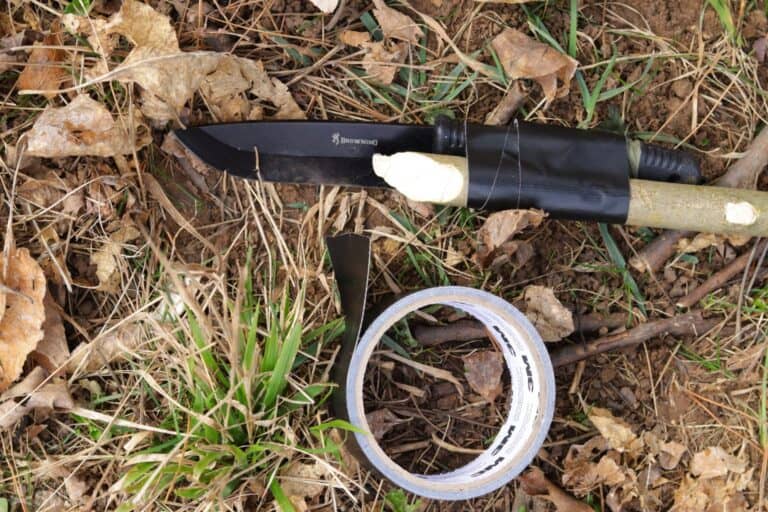
If you are after smaller fish there are too difficult to target using a single large knife as a spear, you might have better success attaching multiple, small knives to the haft in order to make a sort of trident or gig, increasing your chances of successfully nabbing a fish while minimizing damage to the meat.
Here’s a video of a group of people hunting boar with a knife and the help of a few faithful dogs:
To Eat
If you want to impress your friends on your next camping trip, you might as well use your knife. This could work in a survival situation in case you don’t have forks or spoons, although I wouldn’t count on eating soup with a knife.
Compared to your filthy, grubby hands using any kind of utensils, a category with your knife obviously belongs to, is far more hygienic and sanitary for the handling and eating of your food.
It is an easier thing to clean your knife and then use it during mealtime than to get your hands completely clean and eat with them, since the resilient steel is not nearly as likely to harbor germs in various nooks and crannies as your hands are.
You can expect a greater reduction of germs using only water and a cloth to thoroughly wipe off your knife’s blade than doing the same with your hands.
For a long time knives were really the only utensil that was used to handle food, being capable of cutting, piercing and lifting a bite to the mouth, there’s no reason you cannot do the same today in lieu of carrying extra utensils around or just in case you don’t have such utensils close to hand.
To Chop Wood
Nothing beats an ax or a machete but you never know when you’ll have to rely on your knife.
Don’tr try this with your edc knife, though, you need something sturdier, such as your bushcraft knife. Even better, get two bushcraft or survival knives and use the back-up one for tasks such as these. Since you’ll be relying on your main one for life and death situations, you should keep the blade in top shape.
Any good, heavy knife can chop wood but for processing larger branches or small trees you’ll need to employ a baton.
In an austere environment, a baton is essentially a simple wooden club that you can make from any sturdy, nearby branch. You use the baton to pound the knife through the wood that you need to chop or split.
This is necessarily hard on the knife which is why you should only attempt it with the strongest of blades unless it’s a serious emergency, but generally this technique hardly uses more energy than an axe or other purpose made chopping tool.
Even if you do carry an axe, hatchet or tomahawk specifically for processing wood in a survival situation, you should know how to baton wood with your field knife as a backup technique.
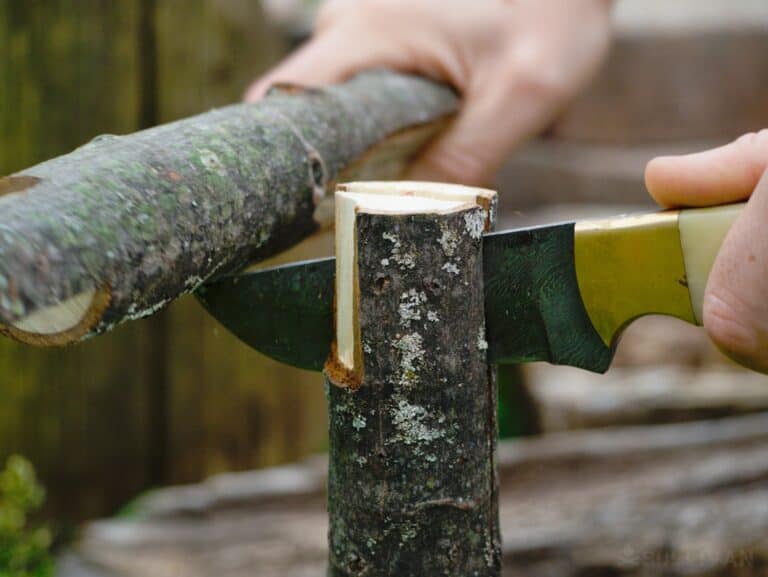
You can almost always find a branch to turn into a baton nearby, and since your knife likely lives on your belt you are less likely to be separated from it than a larger tool that you have to carry.
To Whittle
There are a lot of things you can carve with a knife such as a wooden spoon, a fire bow and drill, even a container to store water, for instance. You can even whittle to pass the time when you have nothing else to do but wait!
For carving intricate shapes or designs you ideally need to employ softwoods such as pine and basswood. The other important thing is to have a sharp knife!
One important prep you can whittle is to make feather sticks for kindling before starting a fire.
Shaving tiny slivers of wood off of dry branches and twigs will make ready kindling, and even splitting and “fuzzing” the ends of larger twigs will make them catch fire easier.
Just take care in your whittling since much of the techniques involve pulling the blade toward you under control; you can ill-afford a sliced thumb or palm in a survival situation!
For Protection
Using a knife for self-defense has advantages and disadvantages.
In the advantage category they are certainly effective, capable of inflicting and piling on serious damage to an attacker, both men and beasts, very rapidly and are also faster into action than a gun assuming you are not starting with the gun already in your hand.
Knives do not malfunction, they generally do not break and also don’t require extensive training to use at a level of basic competency; simply get the edge or point into contact with the critter that is attacking you and press hard!
But in the disadvantage category once again you must be awfully close to employ a knife, even if using it in the fashion of a spearhead.
The ability to make use of tools to dole out damage at a safe distance is one of mankind’s best attributes and advantages over the animal kingdom.
For this reason, knives are commonly seen as self-defense weapons of last resort. Then again, you’re likely to have your knife even when all other options are gone.
Obviously your knife can be used for protection, but what may not be obvious is how to actually use it effectively.
Though watching a video won’t help you much, you can watch the following to decide if this is something you want to learn from an instructor:
To Carve Markings and Write Stuff
Maybe you’re lost and you need to make carvings on trees. Maybe you need to leave someone a message.
Leaving messages for potential rescuers or members of your group or party that have become separated is a great idea in a survival situation.
The only issue is that you are often not able to whip out your phone and simply send them a text message or an email.
You can leave behind notes written on all kinds of things, but written notes have a tendency of being washed away, sun-bleached or otherwise obscured.
Paper is easily destroyed by moisture or birds and rodents who will chew it up to line their nests. This seems to be something of a conundrum.
The obvious solution is of course to engrave your message into something, be at the bark of a tree or even scratching it into a rock.
I don’t have to tell you how survivable engravings are compared to other forms of writing and communication and natural environments.
We can read the engrave writings of ancient civilizations today, and they have weather the centuries and millennia well.
Any knife made from high-quality steel will easily handle such treatment, especially in a softer surface like bark or wood, and will still hold up fine used cautiously on rock.
Engraving can take time and requires care to avoid mistakes or damaging your knife but it’s something that anyone can do with virtually no practice.
To Cut Vines and Branches
Whether you’re looking to build a shelter or fire, or just blaze a trail you can always use a knife to cut down tree branches. The trick is to cut them at an angle, not perpendicularly.
As you strike with the knife, it has to go with the grain of the wood or fibers of the vine, not perpendicular to them. This will ensure you can cut your way through with far less effort and with greater speed.
Even More Uses?
Definitely. A knife is the original frontier and survival situation multi-too. Check out some of the possible uses for your knife just below:
To clean fish and game. A sharp knife can make short work of skinning and processing your catch, be it fish, fowl or mammal. This type of work will usually dull a knife quickly so make sure you keep a sharpening stone handy as part of your kit.
As a hammer. Any knife with a flat pommel or a flattened protrusion on the butt can be used for hammering, either to drive in tent pegs or nails or to crush something.
This is obviously a task that needs to be done with care especially if you are attempting it without a sheath over the blade, but many larger knives will handle these simple pounding chores with ease.
To dig things up. Knives work well for digging in softer soil, or harder soil that does not have a ton of rock or gravel in it.
For cutting through roots or just popping recalcitrant veggies out of your garden, a tough knife can definitely do the job of a trowel or cultivator.
As a pry bar. Any knife can be used as a pry bar for light-duty tasks, like removing staples or tied wire, but heavy duty blades can be used for prying nails, hinges, and other seriously stuck or fastened objects.
Always be cautious when using your knife in this way as it entails greater risk to yourself and your tool.
As a screwdriver. Knives make great screwdrivers in a pinch, able to handle both Phillips and slotted screws. Some knives or even purpose made width standard size protrusions on the cross guard or somewhere on the handle for exactly this purpose.
For First-Aid. You’re nice can come in handy in a variety of first-aid situations. Everything from Lancing boils too neatly cutting off sutures.
You can even use them to remove splinters or insect stingers that are stuck fast in flesh. You will always find a use for a sharp, nimble knife and that definitely applies to first-aid.
To pop a beer. You can use the cross guard, finger choil or spine of your knife to easily open bottles. Impress your friends and look cool doing it! But better hurry, beer has a short shelf-life so you’d need to drink it all before it spoils in a grid-down situation!
To anchor things into the ground. If you are in a serious bind I need a quick anchor, you can firmly jab a large knife deeply into the ground and use it as a light duty tie-down point.
To sterilize wounds. This is a grim and agonizing procedure, but you can use the side of your knife’s blade to sterilize a cut or laceration by first heating it piping hot in a fire and then pressing it into the wound.
This is not for the faint of heart, and you must be cautious since you run the risk of ruining your knife’s temper, weakening it.
Open your mail or packages. Because obviously! Well, why not?
Sharpen a pencil: A pencil sharpener is one of those tools you will never, ever think twice about until you need one and don’t have one.
This is a handy skill to have any time you’re on a construction site but also in a survival situation if you have misplaced your pencil sharpener I need to put a point back on your writing implement.
This does take some practice, but is definitely a cool skill to know!
Further Recommendations
- To avoid cutting yourself, you may want to wear protective gloves. They are really cheap and they should be part of your bug out bag or INCH bag anyway.
- If possible and expedient you should avoid using your knife for things other than cutting and always endeavor to have the right tool for the right job. A multi-tool is your best friend for many of the things listed above. Sure, there was a time when using a knife to do most of these things was normal, but protecting the blade by not abusing it for as long as you can. Also, keep in mind you might void the warranty if you use it in a way that wasn’t intended!
- Always keep your knife sharp! If you don’t, you might spend a lot of energy to do some of these things and the risk of accident and injury climbs in direct proportion to the dullness of the knife; using more force to do the same task means that a slip or fumble is more likely!
- If you’re out into the wild and you don’t even have a knife, use a sharp stone to replace it. Anything with a sharp edge can serve as a knife in a pinch.
- Consider having more than one knife. A larger, sturdier blade for heavy-duty chores and a smaller “support” blade for delicate tasks. A fillet knife for skinning, a folding knife for self-defense, and even a larger knife for processing wood and skinning bigger animals such as deer.
Conclusion
There is almost no problem that cannot be solved, at least partially, with nothing more than a good knife.
Ask any experienced prepper what tool they are completely unwilling to go without and chances are good it will be their trusty knife.
Give this list of tasks that a knife can accomplish a good look and you are certain to come away with a few new tricks.
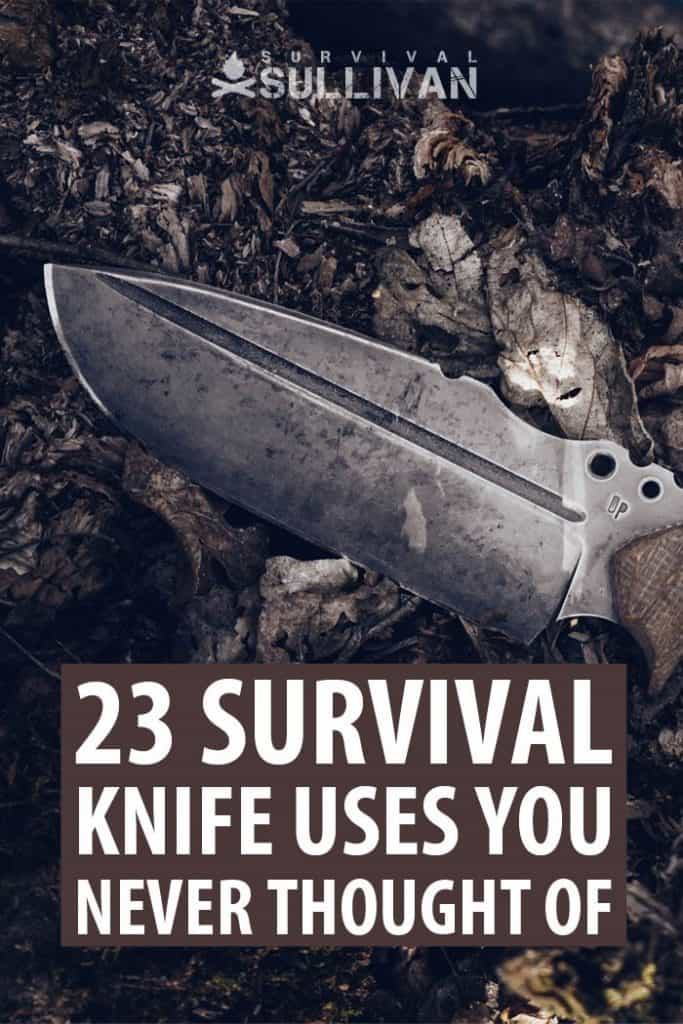

My dad was military. My grandfather was a cop. They served their country well. But I don’t like taking orders. I’m taking matters into my own hands so I’m not just preparing, I’m going to a friggin’ war to provide you the best of the best survival and preparedness content out there.

The axe is there to do more efficiently than what the Marine Ka-Bar in D2 steel would take longer and is more work. IT IS NO PLACE TO CHEAP OUT EITHER!! A Wetterling or Granfor Bruks will set you back a little, but the wooden handle is capable of being something steel and polymer handles don’t do well – be made into shavings fir a fire. Last gasp, yes, but better than no gasp at all. Sharpening: unless you spend $250 on a brand with the word “Professional” in it’s name and looks like it is built like a tank. I’ve tried Lansky and Gatco and others, but alas,,,back they went. Easily bowed rods made it impossible to bear down and move material – Junk. The flip open diamond stones from DMT will outlast you and do an excellent job.. I’m oriented towards Smiths Arkansas stones and honing oil. It takes time and practice, but my Dad started me at 6 learning how, so I can generally do a reasonably good job.
Having a pencil sharpener with you would work better for sharpening pencils as well as sticks. It would also be useful for making kindling while sharpening those pencils or sticks.
You ‘can’ eat soup with a knife, but…it’s very, very slow and messy.